Dear Friends,
We are well into 2017 and rejoice in all the amazing projects that are presently underway. Read on for this month's news about new multimedia, reprints of your favorite free books, new teachings and advice on our website, and more.
New Multimedia Title: The Best Answers Come Through Meditation
Meditation is really worthwhile; it gives you the answers you want. Meditation is the real personal computer. Answers you discover for yourself through meditation are much more meaningful, much deeper, than those you get from somebody else’s replies to your questions.
- Lama Yeshe
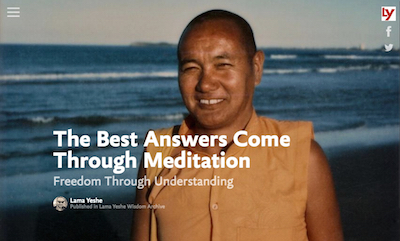 In this latest offering from LYWA's Freedom Through Understanding multimedia series, Lama Yeshe calls upon us to turn intellectual knowledge into living reality through meditation. Lama then graciously answers questions from students on a variety of topics including the karma of being born female, how to manage the negative mind once it is recognized, what meditations to do upon waking and before sleep and the reasons we must dedicate the merit of our actions.
In this latest offering from LYWA's Freedom Through Understanding multimedia series, Lama Yeshe calls upon us to turn intellectual knowledge into living reality through meditation. Lama then graciously answers questions from students on a variety of topics including the karma of being born female, how to manage the negative mind once it is recognized, what meditations to do upon waking and before sleep and the reasons we must dedicate the merit of our actions.
This new title adds to our growing collection of multimedia Dharma presentations, including the Bodhisattva Attitude multimedia series and a number of individual titles. Please see our full multimedia catalog here. We hope your experience of this precious Dharma is only deepened by engaging the Dharma in this multidimensional way.
Making Life Meaningful republished as Print-On-Demand
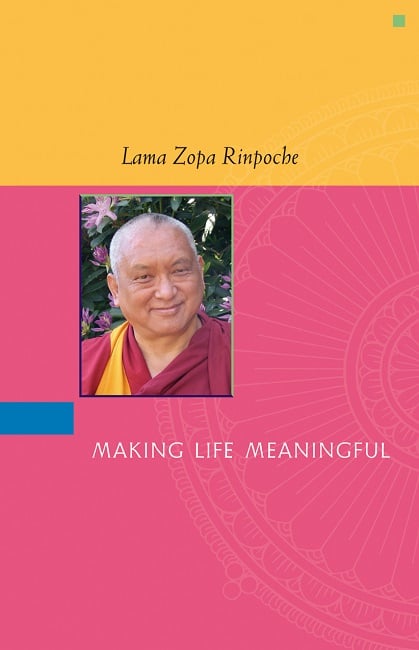 We have recently updated and republished Lama Zopa Rinpoche's classic text Making Life Meaningful and have made it available to order through Amazon's print-on-demand service. After years of being out of print, you can now order a print copy of your very own. As always, you can read the book online or download a pdf, and we have posted the updated version of the ebook to our vendors and to our Members Area.
We have recently updated and republished Lama Zopa Rinpoche's classic text Making Life Meaningful and have made it available to order through Amazon's print-on-demand service. After years of being out of print, you can now order a print copy of your very own. As always, you can read the book online or download a pdf, and we have posted the updated version of the ebook to our vendors and to our Members Area.
This new print-on-demand title adds to the three other titles that we have already made available in this way: Lama Yeshe and Lama Zopa Rinpoche's Advice for Monks and Nuns, Lama Zopa Rinpoche's Teachings From the Vajrasattva Retreat and Geshe Jampa Tegchok's The Kindness of Others. We are happy to be able to offer everyone the opportunity to own these precious titles in print to anyone who wants them.
More Free Books Being Printed
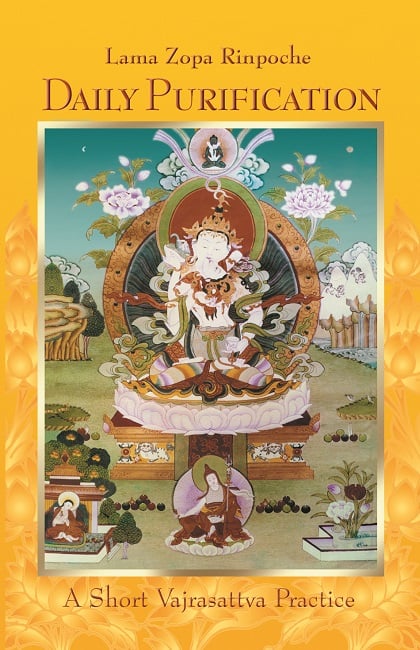 Meanwhile, we are happy to be able to reprint larger quantities of our most popular free books. This month, we have just ordered reprints of 4 titles, which are nearly out of stock: Lama Zopa Rinpoche's Daily Purification: A Short Vajrasattva Practice, Virtue and Reality, and How Things Exist, and Lama Yeshe's The Essence of Tibetan Buddhism. With this round of reprints, we now have nearly 770,000 free books in print, not to mention the countless times our free books are downloaded as ebooks or read online!
Meanwhile, we are happy to be able to reprint larger quantities of our most popular free books. This month, we have just ordered reprints of 4 titles, which are nearly out of stock: Lama Zopa Rinpoche's Daily Purification: A Short Vajrasattva Practice, Virtue and Reality, and How Things Exist, and Lama Yeshe's The Essence of Tibetan Buddhism. With this round of reprints, we now have nearly 770,000 free books in print, not to mention the countless times our free books are downloaded as ebooks or read online!
We often hear from readers about how these books have been so helpful to them, but most poignant are the letters we receive from prisoners. Through the work of amazing organizations like Liberation Prison Project and the program our own Ani Desal runs to establish libraries of our books in prisons through their chaplains, the teachings of Lama Yeshe and Lama Zopa Rinpoche are reaching so many eager readers. One prisoner wrote to us:
With love and compassion to all I am currently in man-made jail trying to find my way out through love and compassion for others! Your book "Virtue and Reality" found me and changed my life. I wish to learn so I may help my family and others in this world, so I can learn to spread true love and compassion. Thank you all for your work and teachings...
We are grateful to our many supporters over the years who have partnered with us to bring these precious teachings to readers all over the world. We invite you to make a contribution toward these reprints and share in the merit of making the Dharma available to everyone, everywhere.
What's New On Our Website
We have just posted a new teaching by Lama Yeshe where he discusses the real meaning of Dharma and the nature of the mind. This discourse was given at Chenrezig Institute, Eudlo, Australia, on September 8, 1979. Edited by Nicholas Ribush. An excerpt from this teaching is included as this month's eletter teaching below.
Also this month, new additions to Lama Zopa Rinpoche's Online Advice Book include:
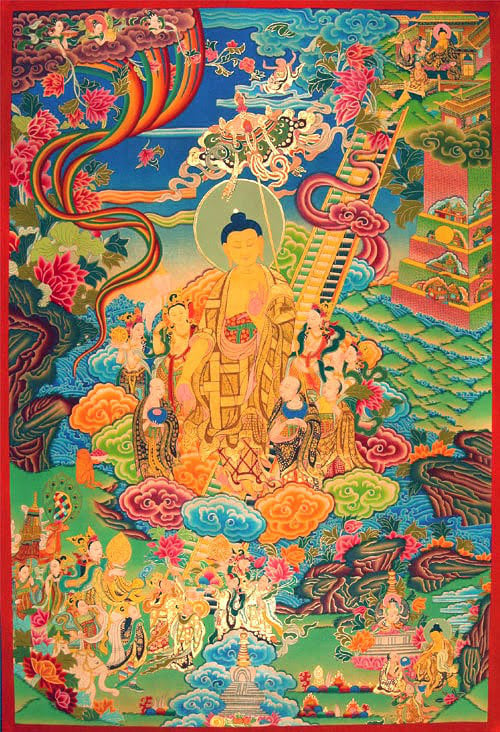 • The Purpose of the Buddha Descending to this World: In this advice given to a Dharma center, Rinpoche explained the essence of the Buddha’s teachings and the benefits of precious mantras.
• The Purpose of the Buddha Descending to this World: In this advice given to a Dharma center, Rinpoche explained the essence of the Buddha’s teachings and the benefits of precious mantras.
• The Bodhicitta Path: After a serious accident, a student found it difficult to practice and wrote to Rinpoche for advice. Rinpoche recommended tonglen and other essential practices.
• Sincerely Respect Elder Sangha: Advice about respecting and cherishing all sentient beings, and in particular, respecting geshes and elder Sangha.
• Daily Practices and Tonglen Advice: Rinpoche gave this practice advice to a student who had requested guidance. The student had become unwell after doing tonglen for sick friends.
There are many more new advices added this month and, as always, you can view a list of all the recently added advices to Rinpoche's Online Advice Book on our website.
This Month's Podcast: Chöd: Slaying the Ego
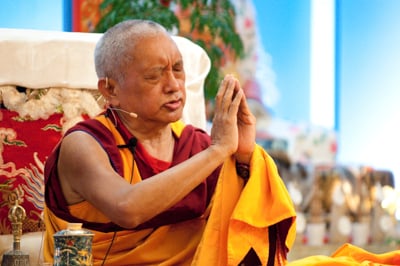 is this wonderful excerpt from a series of teachings given prior to a chöd initiation by Lama Zopa Rinpoche at Maitripa College, Portland, Oregon, in June 2009. In this teaching Rinpoche explains:
is this wonderful excerpt from a series of teachings given prior to a chöd initiation by Lama Zopa Rinpoche at Maitripa College, Portland, Oregon, in June 2009. In this teaching Rinpoche explains:
Practicing Dharma is just a question of changing, you know, your own mind, changing, from self-cherishing thought into cherishing others, from anger, those violent, harmful mind, into loving-kindness, compassion to others, so, basically like that.
Our podcast has recently been redesigned and revitalized, and you can download previous episodes and find out how to subscribe on our podcast page.
After listening to the podcast, you can listen to more from this teaching, and read along with the unedited transcript, on our website.
Prayers for Lama Zopa Rinpoche
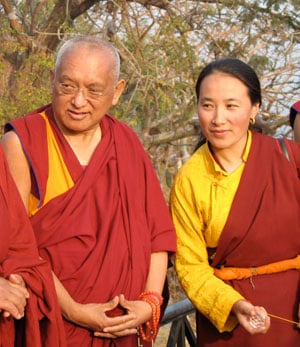 Every year FPMT CEO Ven. Roger Kunsang, on behalf of the FPMT organization, checks with one of Lama Zopa Rinpoche’s gurus and also with Khadro-la (Rangjung Neljorma Khadro Namsel Drönme) to determine what practices should be done to help create the conditions for Lama Zopa Rinpoche to have good health for the coming year. Khadro-la has recently advised that it would be very beneficial if all FPMT centers, projects, services, and study groups can arrange regular recitations of the Vajra Cutter Sutra and the prayer Dependent Arising: A Praise of the Buddha (Tendrel Topa).
Every year FPMT CEO Ven. Roger Kunsang, on behalf of the FPMT organization, checks with one of Lama Zopa Rinpoche’s gurus and also with Khadro-la (Rangjung Neljorma Khadro Namsel Drönme) to determine what practices should be done to help create the conditions for Lama Zopa Rinpoche to have good health for the coming year. Khadro-la has recently advised that it would be very beneficial if all FPMT centers, projects, services, and study groups can arrange regular recitations of the Vajra Cutter Sutra and the prayer Dependent Arising: A Praise of the Buddha (Tendrel Topa).
FPMT are requesting everyone to join in and keep track of their recitations of these prayers during the rest of this Tibetan year, at which time the total number of accumulated recitations will be offered to Rinpoche. See the FPMT website for links to the prayers, the suggested dedication, and more information about the advice.
Thank you again for your incredible support, and please enjoy this teaching from Lama Yeshe.
Much love,
Nick Ribush
Director
This Month's Teaching: What is Dharma?
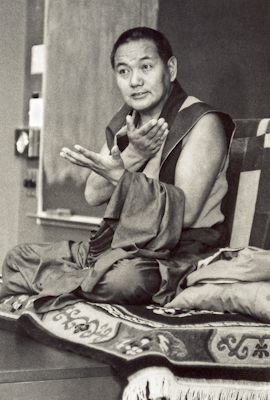 The human consciousness, the human mind has a relative nature which is clean, clear energy and has the ability to reflect all existence. Therefore, if we contemplate on our own relative characteristic or consciousness, which is the clean, clear energy, it automatically eliminates the concepts which make us irritated, trouble us. So, we say the human being is profound. I am sure that Lama Zopa explained the precious human rebirth. The reason it is precious is because it has profound potential, profound quality. Even you can say pure quality, pure quality. The sense of this is that relative character of the human conscious is not totally mixed up with negativity or sin. That's all I am saying, that relatively thinking that the human being is negative and sinful is wrong.
The human consciousness, the human mind has a relative nature which is clean, clear energy and has the ability to reflect all existence. Therefore, if we contemplate on our own relative characteristic or consciousness, which is the clean, clear energy, it automatically eliminates the concepts which make us irritated, trouble us. So, we say the human being is profound. I am sure that Lama Zopa explained the precious human rebirth. The reason it is precious is because it has profound potential, profound quality. Even you can say pure quality, pure quality. The sense of this is that relative character of the human conscious is not totally mixed up with negativity or sin. That's all I am saying, that relatively thinking that the human being is negative and sinful is wrong.
In one of Maitreya's texts is an example of how the potential of the human consciousness is clean clear; how it has never been of negative character and will never be of negative character either. It is like the nature of the sky—the sky nature is always clear, it hasn't got the character of clouds and will not have. This example is so clear. The cloud character and the space character are different. It's the same thing that our consciousness has clean clear nature. But when we are caught by the ego's wrong conception way of thinking, the concepts that identify that-this, that is what is wrong. But I am not saying that that is always wrong, the that-this thinking. But most of the time our thinking that-this has nothing to do with reality, it's only a superficial fantasy.
My point is, that any time, no matter how much you are confused or fearful or in a suffering situation, if you look into the clarity of your consciousness, your mind—it is always there, always there. This is the human beauty: the human being has the ability, the human consciousness has the ability to perceive things - good or bad, whatever it is—and also to use the wisdom which discriminates what is worthwhile and what is not worthwhile. Good or bad, impure or pure, we can discriminate—that is the human beauty. Don't think that human beings are hopeless—that's not true. You are not a good meditator therefore, “I am hopeless,” that is also wrong. “I cannot sit like this for one hour therefore I am not a meditator.” Again, your limited judgment. We do. Who in Buddhism said that you can only sit this way to become enlightened, who said? Where is that man? That's why the human beauty, human profundity, is always existent, always existent. Even though intellectually you make yourself too limited, it is always existent.
You should not think, “Buddhism makes me good or bad. But now I have many things to count by, this is good or this is bad.” As long as the relative mind is moving, concepts moving, day and night, twenty-four hours, the karma, or good-bad is existent. It is like, if I ask you Western people when we produced television, “Is television a fantastic vehicle?” When it first came out everybody said, “Wow, yes, fantastic.” But now maybe some hippies say television is horrible. Because there are too many garbage reflections. Similarly with our consciousness; it is kind of like a clean clear screen: it has the ability to reflect phenomena. So you look at this one. Here you have real television; your consciousness is television, so we should look at it, we should contemplate on that clarity, and penetrate. In that way we can discover tranquility and peace.
When we say “Dharma,” Dharma is our consciousness, part of our mind. Dharma book is not Dharma. Dharma teacher is not necessarily Dharma. Dharma philosophy is not Dharma. Dharma doctrine is not Dharma. Dharma is the action of part of our wisdom energy which has the power to eliminate one thing in particular, the concepts of delusion. In other words, it becomes the antidote or solution to particular delusions and dissatisfaction. Then it is worthwhile; that is the reason the Dharma is worthwhile. That's the reason that we say Dharma is holy, Dharma is worthwhile. Otherwise if you understand wrongly, Dharma is not worthwhile, Dharma becomes a problem. You know—we already talked before how Dharma becomes a problem. So developing comprehension of the relative mind or relative consciousness is the source of developing comprehension of the absolute character of the mind.
Also, that relative mind is an interdependent, composite gathering, an interdependent gathering of energy; not one absolute thing. When we say, “I am deluded,” you cannot blame this side, “The perception side is bad, I want to smash.” Also you cannot blame the object side, “That is bad, I want to smash.” Let's say, when I have some dirt on my face, I look in the mirror—“Wow! I am dirty, ugly. Oooh!” You cannot blame the mirror, nor can you blame your face, “I want to cut this off.” So what, what? The thing is that the gathering makes this phenomenon, isn't it?
So the same thing, no matter how much we think, “I am bad” or “I am terrible,” the conception thinking these things, if you check it out it is a composite gathering. Many factors gather and then we say that, “That is this, that, this.” If you know all of these things, each part gathers to make the relative phenomena, you can understand that there is no concrete relative phenomenon inherently existent. Then you can see. All relative phenomena are superficial, impermanent, momentary, set up in such a way; then we say that, this, that, this, that, this, including ourself.
You see, actually, it has never occurred to our conception of ego, it has never dreamed, that the entire relative character of the I is composite energy, many parts of energy have gathered to become a bubble or some kind of cloud. As a matter of fact, our body is like a cloud—one bunch of clouds come, one bunch of energy comes—this is the body. Each day when you wash, some part of the energy goes from the skin; each time you breathe, some kind of energy goes out here with the breath. Then you eat, again some kind of energy goes inside. I think you know these kinds of things better than I, maybe.
This excerpt is from a discourse given by Lama Thubten Yeshe at Chenrezig Institute, Eudlo, Australia, on September 8, 1979. Edited by Nick Ribush. You can read the entire teaching on our website.































